
(Updated at 5 p.m. on 7/3/23) Arlington Independent Media is Arlington’s public access TV channel, its community radio station, and a media training provider.
Under its current leadership, AIM — which was founded in 1982 — is trying to broaden its reach and uplift diverse residents. Reaching this goal, however, is hampered by messy finances: audit reports from 2018-19 show it has been losing money, while its 990s are behind schedule and staff are not getting paid on time.
Bringing Arlington Independent Media, or AIM, into the 21st century, increasing its name recognition and charting a new financial course is slow going.
Arlington County has chipped at AIM’s operating expenses recently to lessen its reliance on tax dollars — though cuts in 2018 were partially restored after public outcry, on the condition the organization would up fundraising. Meanwhile, the organization has to watch a once-reliable cable franchise agreement, which provides funding based on local cable TV subscription numbers, become increasingly unpredictable.
Arlington pays for AIM’s operational budget while revenue from the cable agreement, dubbed Public, Educational and Government (PEG) funds, go toward its capital expenses. As cable subscriptions dwindle, though, Arlington County has to decide where to prioritize funding.
Recipients for PEG funding include AIM, the broadcasts of county government meetings and work sessions, the county’s dark fiber network, and certain Arlington Public Schools initiatives.
“Our approach has been to review and consider all eligible expenses submitted to the County by AIM and other eligible entities,” spokeswoman Bryna Helfer said.
It is unclear how many people listen to and watch AIM. It has 322 paying members, down from 577 in 2019, while broadcasting metrics are too expensive and radio analytics efforts for WERA 96.7 FM are nascent, according to its CEO Whytni Kernodle. She says a better metric is its several community-based partners and its work to center diverse voices, including a scholarship for budding journalists whose parents do not speak English at home or are low-income.
“We are an outside organization that is attempting to use the power of the people to really uplift the community in general by focusing on the most marginalized,” she said.
With the operational and capital funding sources each drying up, AIM should do more fundraising, the county insists. Kernodle counters that the county controls the PEG funding and could give it to AIM but is funneling it to other initiatives and creating a backlog of PEG-eligible expenses.
“The problem is not lack of available funds or that the request is not an acceptable one under the guidelines, but that the county has other priorities for future usage of those funds,” she wrote in a March memo to the county. “This is clearly inequitable and alarmingly questionable as to appropriate usage of funds managed, not owned, by the County.”
Arlington County Board Chair Christian Dorsey told ARLnow that AIM received $660,000 in PEG funding last year. That’s actually an increase from years past, Kernodle said, chalking it up to her persistent requests — but she thinks more is warranted.
“We’re attempting to do the best we can,” she said. “What we’re trying to do is create a situation where something formed in 1982 can thrive now, and for those running it 40 years from now.”
AIM is not protected from fluctuations in funding, Kernodle noted, and its record-keeping is a work-in-progress. She learned when she started that the organization was 1.5 years behind on its taxes and its auditor was missing-in-action.
“The executive team before me got into community media because they believed in the mission,” Kernodle said. “They did the best they could but there are things we should’ve done 15 years ago. We can blame Arlington, Comcast or AIM, but negotiations should have happened. Planning, prioritization of funds should’ve happened.”
There are signs of a solution. Arlington County says it is working through submitted invoices and the two are considering hammering out a memorandum of understanding.
“As with all its other partner organizations, the County Board expects that AIM will manage and adapt its budgets and operations to allow it to deliver on its mission,” Dorsey said. “The Board and County staff look forward to continuing to work with AIM to align our understanding of county support and expectations regarding future PEG fund requests.”
Local officials know, however, that there is more competition for fewer PEG dollars as people cancel their cable subscriptions in favor of streaming services. The streamers, unlike cable companies granted local franchise agreements, do not remit funds to the county government.
“The media landscape has changed substantially since AIM first began providing services to Arlingtonians in 1982,” Dorsey said. “Funding for public, education, and government video programming is likely to continue their decline.”
His suggestion to diversify funding sources requires bandwidth for existing employees that Kernodle says they do not have. Staffing at AIM has dropped from 11 employees to five full-time and two part-time staff, who are responsible for programming and fundraising.
Kernodle says the last time AIM was fully funded was in 2016, when it was under an agreement with the county allotting AIM 1% of cable revenue for operating expenses, PEG funds for capital expenses and a rent-free studio.
As of 2018, the county entered a new agreement axing the Comcast-provided rent-free studio and requiring AIM to apply for operating expenses like other nonprofits.
The county has since provided $4 million in contributions and last year agreed to let AIM operate a studio in a county-owned building in Green Valley, Dorsey said. That could be ready this fall.
“While the County will continue to provide support where possible, we hope to see AIM diversify its revenue streams to remain responsive to this change in media consumption,” he said.

